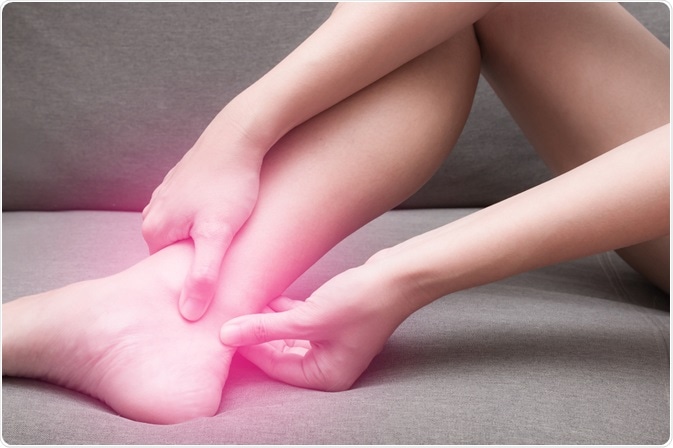The usual presentation of tendonitis is load-related pain coinciding with increased activity and inflammation in the affected tendon. Before the onset of their symptoms, most patients with tendonitis have engaged in a new type of activity or increased the intensity of current activity.
 Image Credit: catinsyrup/Shutterstock.com
Image Credit: catinsyrup/Shutterstock.com
In the early stages, pain can be present during activity but often recedes after a warm-up period. Pain can gradually increase in intensity and duration, but can also be present while resting in later stages of the disease. Patients often describe their pain as sharp or piercing during aggravating activities, but then it becomes dull while resting.
Prominent symptoms of tendonitis
In rotator cuff syndrome, pain while moving the arm (particularly when it is lifted up high) and when lying on the shoulder at night are the most common symptoms, as supraspinatus tendon and other tendons of the shoulder are affected. If calcifying tendonitis develops in the shoulder, it is often followed by long-term mild pain and stiffness in the neck, with short episodes of severe pain irradiating into the neck or down the arm.
Biceps tendonitis can also cause pain in the shoulder which may travel down to the elbow and forearm. Pain also occurs when the arm is raised overhead. Moving the thumb is very painful in DeQuervain’s stenosing tenosynovitis, due to the swelling and thickening of the sheath surrounding the thumb tendons.
Tendonitis of the patella (jumper's knee) may cause pain during running, fast walking, or jumping, and it can also increase the risk for ruptures or large tears to the tendon. Achilles tendonitis typically begins as a mild pain in the back of the leg or just above the heel following sports activity. Prolonged running, stair climbing or other similar activity can result in a prominent pain along the back of the leg, and the patient can also experience tenderness and stiffness in the morning.
What is Tendonitis?
Clinical signs of the disease
Clinical examination can reveal tendonitis with three tests: stretching, isometric contractions, and palpation of the affected area. Although often limited by the anatomic location of the tendon, palpation usually elicits well-localized tenderness, similar to the pain experienced during activity.
Swelling, erythema, and asymmetry are common signs of tendon disease such as tendonitis, so they can be readily observed during physical examination. The range of movement is limited on the symptomatic side, and the tendon sheath can sometimes become thickened, resulting in a creaky sound that can be heard when attempting to move the tendon.
When in doubt about the correct diagnosis, imaging tests are often carried out to provide more information on the type of injury. Plain-film radiography can show calcium deposits around the tendon, which may indicate calcifying tendonitis, or sometimes even expose that a bone is fractured.
Further imaging studies are usually reserved when the diagnosis remains unclear despite thorough history and physical examination, and also when conservative management fails to alleviate the pain. Ultrasonography and magnetic resonance imaging (MRI) is most often employed, although the tendon morphology does not necessarily correlate with clinical symptoms.
References
- http://www.aafp.org/afp/2005/0901/p811.html
- Jeffrey H. Weinreb, A. (2014) "Tendon structure, disease, and imaging", Muscles, Ligaments and Tendons Journal, 4(1), p. 66. Available at: https://www.ncbi.nlm.nih.gov/pmc/articles/PMC4049653/ (Accessed: 30 September 2021).
- Jean-François Kaux, J. (2011) "Current Opinions on Tendinopathy", Journal of Sports Science & Medicine, 10(2), p. 238. Available at: https://www.ncbi.nlm.nih.gov/pmc/articles/PMC3761855/ (Accessed: 30 September 2021).
- Achilles Tendinitis - OrthoInfo - AAOS (2021). Available at: https://orthoinfo.aaos.org/en/diseases--conditions/achilles-tendinitis/ (Accessed: 30 September 2021).
- Tendonitis (2017). Available at: https://www.nhs.uk/conditions/tendonitis/ (Accessed: 30 September 2021).
Further Reading